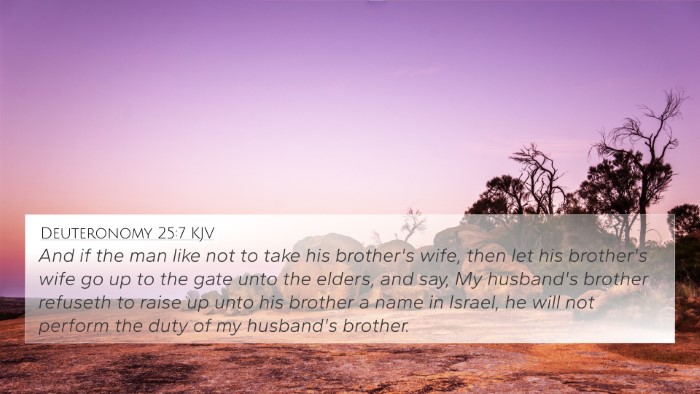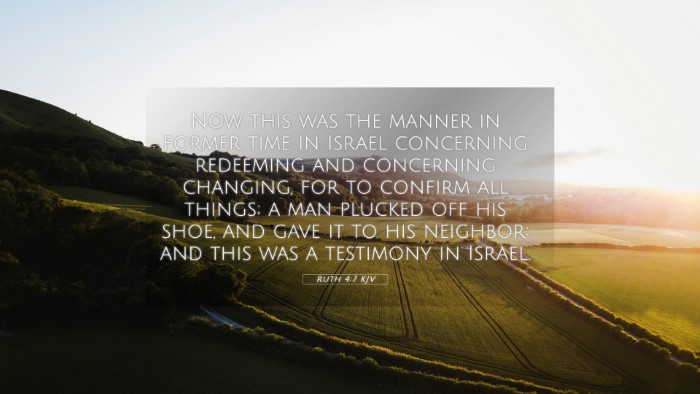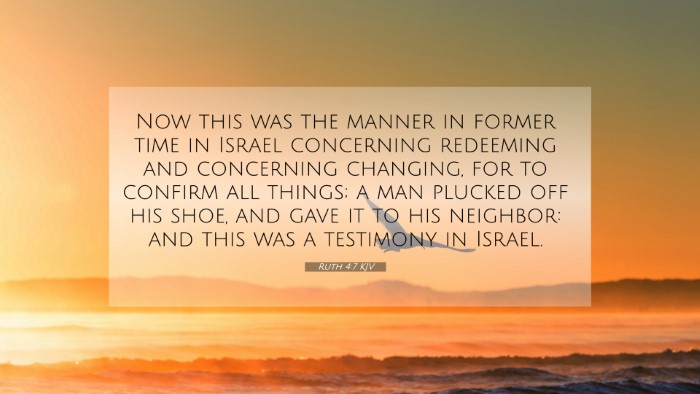Old Testament
Genesis Exodus Leviticus Numbers Deuteronomy Joshua Judges Ruth 1 Samuel 2 Samuel 1 Kings 2 Kings 1 Chronicles 2 Chronicles Ezra Nehemiah Esther Job Psalms Proverbs Ecclesiastes Song of Solomon Isaiah Jeremiah Lamentations Ezekiel Daniel Hosea Joel Amos Obadiah Jonah Micah Nahum Habakkuk Zephaniah Haggai Zechariah MalachiRuth 4:7 Similar Verses
Ruth 4:7 Cross References
Now this was the manner in former time in Israel concerning redeeming and concerning changing, for to confirm all things; a man plucked off his shoe, and gave it to his neighbor: and this was a testimony in Israel.
Uncover the Rich Themes and Topics of This Bible Verse
Listed below are the Bible themes associated with Ruth 4:7. We invite you to explore each theme to gain deeper insights into the Scriptures.
Ruth 4:7 Cross Reference Verses
This section features a detailed cross-reference designed to enrich your understanding of the Scriptures. Below, you will find carefully selected verses that echo the themes and teachings related to Ruth 4:7 KJV. Click on any image to explore detailed analyses of related Bible verses and uncover deeper theological insights.

Deuteronomy 25:7 (KJV) »
And if the man like not to take his brother's wife, then let his brother's wife go up to the gate unto the elders, and say, My husband's brother refuseth to raise up unto his brother a name in Israel, he will not perform the duty of my husband's brother.
Ruth 4:7 Verse Analysis and Similar Verses
Bible Verse Meaning: Ruth 4:7
Ruth 4:7 reads: "Now this was the custom in former times in Israel concerning redeeming and exchanging: to confirm a transaction, the one drew off his sandal and gave it to the other; and this was the manner of attesting in Israel."
This verse highlights an ancient custom that served as a legal and social practice in Israel, particularly related to property transactions and the concept of redemption. The act of drawing off a sandal represents a formal pledge and acceptance of responsibility in these transactions. In the context of the Book of Ruth, it signals the establishment of a legal right to redeem property, associating it with family lineage and care.
Commentary Insights:
- Matthew Henry: He emphasizes the cultural significance of this ritual as a public declaration of intent and obligation. The act signifies acceptance of the responsibility that comes with redeeming land and family, illustrating a deeper commitment to familial loyalty.
- Albert Barnes: Barnes elaborates that this tradition provided a tangible and visible way to fulfill legal obligations, ensuring that the transaction was clear to all parties involved. He underlines the importance of customs in establishing trust and societal order.
- Adam Clarke: Clarke notes the implications of this verse in the context of the kinsman-redeemer concept, underscoring the theological importance of redemption in the narrative. He connects this practice to broader themes of preservation of family and lineage, which resonate throughout the Bible.
Connections to Other Bible Verses:
This verse draws several significant connections and parallels to themes and practices found throughout the Bible:
- Deuteronomy 25:7-10: Discusses levirate marriage and the custom of a brother redeeming his brother's widow, establishing a direct link to the practice of redemption.
- Leviticus 25:25: Outlines the laws regarding family property redemption in Israel, reflecting the importance of maintaining family lands.
- Jeremiah 32:7-15: Illustrates the act of property redemption through the purchase of a field, reinforcing the kinsman-redeemer motif.
- Galatians 4:4-5: Speaks to Jesus as our Redeemer, making a thematic link between OT practices and NT fulfillment.
- Hebrews 9:12: Connects the principle of redemption to Christ's eternal redemption for believers, emphasizing the ongoing importance of this theme.
- Isaiah 43:1: God’s promise of redemption, where He claims His people as His own, again tying back to the kinsman-redeemer idea.
- 1 Peter 1:18-19: Discusses the cost of our redemption through the blood of Christ, paralleling the sacrificial nature of the redemption in Ruth.
- Exodus 21:6: Highlights a different aspect of legal customs related to servitude and freedom, presenting a broader understanding of community obligation and redemption.
- Romans 8:23: Talks about our hope for the redemption of our bodies, creating a connection between physical and spiritual redemption.
- John 10:14-15: Here, Jesus refers to Himself as the Good Shepherd who knows His sheep and lays down His life for them, showcasing the deep commitment of a Redeemer.
Thematic Relationships:
The thematic connections in Ruth 4:7 extend to both the Old and New Testaments, where overarching themes of obligation, loyalty, and redemption unify various scriptural texts:
- Redemption: The clear connection in the notion of redeeming something for the benefit of family resonates throughout both Testaments.
- Family Ties: The emphasis on keeping property within the family, reflecting God's covenantal commitment to His people.
- Legal Customs: Understanding how cultural practices inform Scripture can aid in interpreting biblical texts.
- Faithfulness: A recurring theme representative of God's unchanging nature in the relationships He establishes with His people.
How to Utilize Cross-Referencing:
When studying Ruth 4:7, it is essential to employ effective cross-referencing tools for a deeper understanding:
- Utilize a Bible concordance to find related verses.
- Incorporate a Bible cross-reference guide to locate thematic parallels.
- Engage with comprehensive Bible cross-reference materials for an extensive study.
- Learn how to use Bible cross-references effectively to link scriptures in your studies.
- Explore cross-referencing Bible study methods that solidify your understanding of scripture.
Conclusion:
Ruth 4:7 serves as a profound example of the intertwining of cultural customs, legal practices, and deep spiritual truths within the narrative of redemption. By linking this verse to others within Scripture, believers can appreciate the richness of God's redemptive plan for humanity, extending from the Old Testament into the New Testament. Understanding these connections encourages a holistic view of biblical texts, fostering deeper faith and comprehension.


